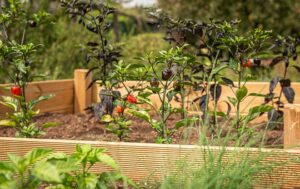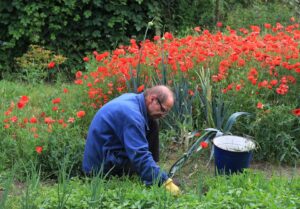How to Prepare Garden Beds in the Fall

The spring and summer months were a busy time for all if not most of us, we worked in our gardens hoping to reap a good harvest from our food crops or to see our ornamental plants come to full bloom as they amaze us with their many shapes, sizes, and various colors. Now we’re in the fall months but we can’t throw up our feet just yet because during the fall months there is still much to do to prepare our garden beds before winter sets in.
We can do much in our fall gardens by spring cleaning, the ideal time to begin cleaning and preparing those garden beds is about six weeks before the first hard freeze. Weeds are an eyesore that harbors garden insect pests, spreads diseases, and competes with garden plants for water, sunlight, and nutrients. So begin by removing weeds and other garden debris such as fallen leaves, fruits, twigs, dead plants, leaves, and branches that are resting on the soil’s surface. This spring cleaning of your garden beds will destroy harborages and discourage garden insect pests from overwintering.
Trenches can also be dug in the garden bed followed by filling these trenches with the fallen leaves and then backfilling the trench with the soil that was removed. Once the trench is covered up completely the leaves will decompose during the winter months, when spring arrives the soil will be nutrient-rich.
Preparing the Soil in your Garden Bed
Mulches are beneficial to garden plants as well as soil microbes, this natural organic is like a gardener’s gold. Before preparing your plant bed for the fall months it’s important that mulches that are in good condition be removed first. Once the plant bed is prepared the mulch can be returned. You may have to add a few more inches of fresh mulch, however.
Loosen Compacted Soil
Harvest all of your herbs and vegetables before tilling the soil, compacted soil can restrict the absorption and movement of water to get where it’s needed (plant roots) most, to solve this problem use a garden fork to turn the soil a bit not too much because heavy soil tilling will encourage soil erosion, destroy the soil’s structure, encourage high soil moisture loss, bringing unwanted weeds seeds that are buried deep in the soil to the surface, may affect the ability for natural warming up of the soil, and can strip the soil of nitrogen. When it comes to soil tilling however there are mixed views as to the advantages vs the disadvantages but if you must use this method, as said earlier the soil should be turned lightly.
Amend your Soil before Planting
Amending your garden soil is a great way to get a great head start, but before this is done consider getting a soil pH test first. Properly amending your garden bed soil will ensure that when the growing season (spring and summer months) arrives your plants will have a good head start. If you’re using organics such as chicken, horse or cow manure ensure these natural organics are dried or composted for a least six months. Installing plants right after applying fresh manure will burn the plant’s roots.
Consider adding some slow-release organic fertilizer at this time as well, once the soils loosen this organic can be added. Use a rake to smoothen out and break up any lumps.

Protecting your Compost
Compost is a gardener’s gold and what we don’t want is to have this all-natural rich organic material destroyed by the cold weather, to protect your compost you can either add 1-2 inches of straw or cover the top with a plastic tarp or a plastic sheet will do. The plastic can be secured by zip-tying it to a nearby post or stacking the edges with rocks.
Inspect your Perennials and Trees for Pruning
Inspect your plants for disease, overgrowth, damage, and discoloration of branches, leaves, and flowers, and prune as needed. The stems of perennials should be trimmed to about 1-2 inches above the soil line. This trimming can help plants to stay healthy during the cold season as they go dormant, laying a few inches of mulch over your perennials will protect the roots from freezing. The scraps or clippings from your perennials can be tossed in your compost bin.
Planting Fall Cover Crops
Planting fall cover crops 4 weeks before the first frost sets in will encourage high microbial activity during the winter months. These cover crops will also restrict weeds from emerging and will help to prevent soil erosion. Plants such as legumes, rye, clover, hairy vetch, and garlic, can be planted and then turned over during the spring months for your vegetable and flower beds.
Empty Rain Water Barrels
Rain barrels that have collected water during the spring and summer should be emptied, draining the barrels at this time will ensure the prevention of frozen water. The barrels should be cleaned once the tubes and pipes have been removed which will reduce the chance of damage from the harsh winter freeze. Before the first frost, remove your garden hose from outdoors, also shut down your irrigation system to ensure that all the water is drained from the system to avoid cold damage.
Apply Weed Killer on the Lawn
Applying weed killer or herbicide to your lawn during the fall months is a great way to get rid of summer weed seeds, this move will prevent weeds from emerging during spring once the lawn revives. If there are children and pets around keep them off the lawn for a few hours because herbicides are poisonous and these chemicals must be allowed to penetrate the weeds. Before applying herbicides read and follow the manufacturer’s directions on the label for the best results.
Installing Plants
Fill in those gaps by planting cool season plants, you may want to install some spring bulbs while you’re at it. This move will help your garden greatly. Shrubs and trees can be planted 6 weeks before the first sign of frost which is from September to November, installing trees and shrubs during these months will allow the roots to be established before the ground freezes and the harsh winter months arrives.
Remove Herbs Indoors
Potted herbs should be moved indoors to protect them from the winter frost, Place herbs in an area indoors that gets bright indirect sunlight. This move will ensure that you’re eating fresh and healthy herbs all winter long.
The final word on preparing your garden for fall
From what we have discussed there is still a lot to do in our fall gardens as we approach the winter months, this fall preparation will not only help in the protection of our garden but give our plants a jump start once the growing season arrives. I believe we should all get busy in our gardens during this time of the year so working the soil can become much easier as we take on those spring and summer garden tasks once the cold has passed.
About the author
Norman loves being in the garden, both at home and for his job....
he is 'Natures Little helper' being outdoors, growing his vegetables and flowers from an early age.
Now having spent over 22 years in the profession he want to give some of his knowledge to others...
his vast array of hints and tips you will find scattered over this site will help you no end growing plants in your garden.

Hey great and helpful post!
I wasn’t aware their was this much work to be done in fall or autumn as well, I literally thought it’s relaxing time or basically we just leave our gardens as it is!
I’ve seen my neighbour a couple of times mending her garden but until today didn’t know the importance. At least now I can help her!
Hello and thanks so much for stopping by, there is a lot to do in our gardens during the fall months, its all in preparation for the winter months and to get a jump start on spring. All the best to you and have a good day!
Norman,
Thank you very much for this valuable and detailed post about preparing your garden for fall. This is really a very important post especially for those living freezing areas. You have explained everything very well.
I agree with you when you say the fall is a great time of year to prepare, protect and till your vegetable garden. In fact tilling breaks down any roots left over from the main growing season.
Tilling also aerates the soil, creating little air pockets that keep the soil moist and provide oxygen for the growing plants.
There is need to preserve natural environment and use it judiciously.
I am so happy to help, thanks so much for stopping by and commenting.